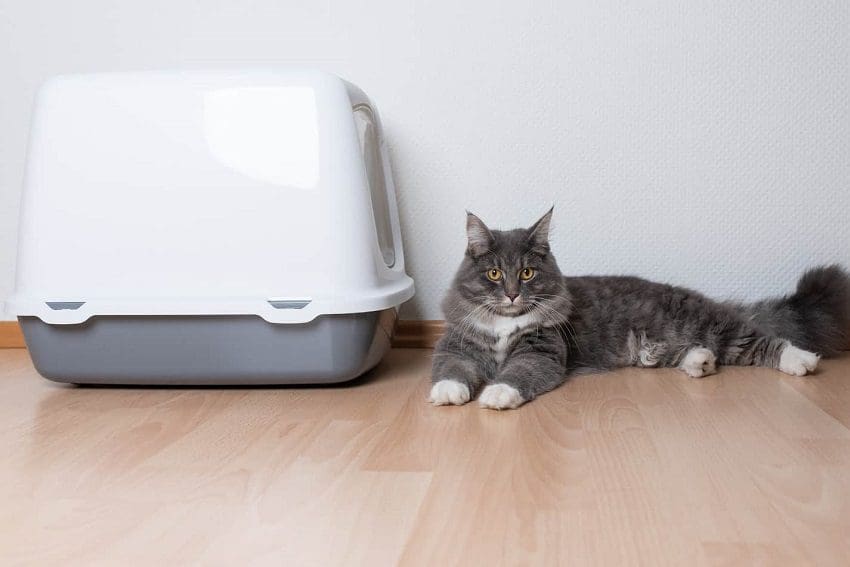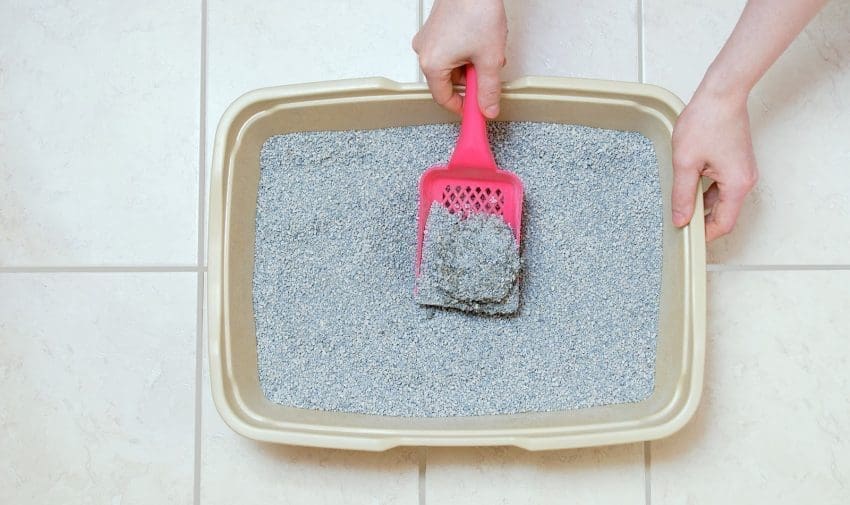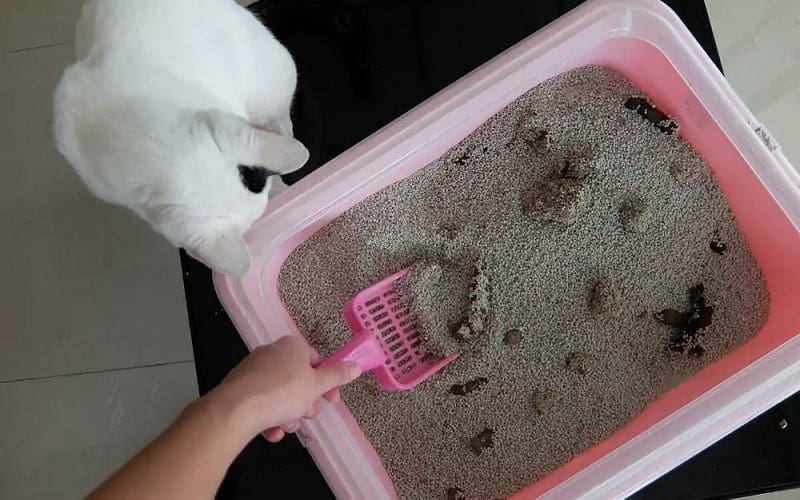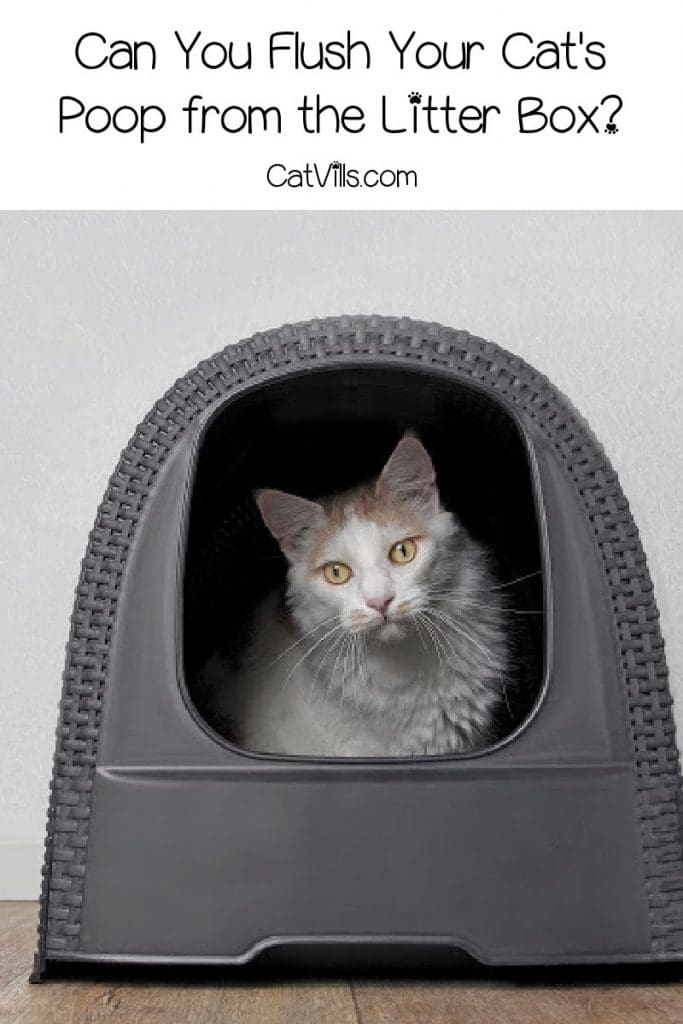Last Updated: 1 year ago
Are you wondering if you can flush cat poop out of the litter box?
It’s not as strange a question as you might think! We’ll satisfy your curiosity and give you the complete answer.
Just keep reading to discover how to dispose of cat poop.
Can You Flush Cat Poop From The Litter Box?

Let’s admit it. No one likes to deal with cat waste, especially when you’ve got multiple cats and several litter boxes to scoop every day.
However, there are a few smells that cats hate more than dirty litter. So, your kitty will find another place if the litter box isn’t up to their standard.
What’s worse, once your cat becomes comfortable eliminating on other surfaces, litter training your cat might be tricky.
Since you don’t want to scoop the mess out of carpets and tiles, the quick disposal of cat poop is so important.
But can you flush it down the toilet and what to do with the litter? Let’s find out together.
Is it Ok to Flush Cat Poop and Litter?

You’ve just scooped the litter box when you notice that your kitty is right back inside for a second round.
Naturally, you start to wonder what happens if you flush cat poop or litter because you’re sick of cleaning the box.
Unfortunately, it’s not okay to flush cat poop or litter in the toilet.
You might think that cat waste and human waste are the same, but you can do more damage than you can imagine.
So, let’s see three reasons why you should never flush cat poop and litter down the toilet.
#1 You Risk Plumage Blockage
Do you know what cat litter is made of?
Most cat litter consists of sodium bentonite (a type of clay), which absorbs moisture and expands up to 15 times its original size when wet.
Clay litter continues to expand when it comes in contact with water. It also hardens and clumps together into cement-like stuff that’s hard to break apart.
Think about the times when you’ve neglected to clean the litter box for a day or two. You had to scrape the mess because it was stuck to the bottom, right?
Now imagine what would happen with your sewer system if you flush the litter. The least that could happen is that the clay will clog your pipes and cause your toilet to overflow.
Depending on how severe the blockage is, you might have to call a plumber to come and unclog your pipework.
However, the litter might also damage your septic system, which would mean that you’ll have to pay for new pipes! It’s better not to risk it unless you’re confident that your cat litter is flushable.
Instead of clay, flushable cat litter consists of biodegradable materials, such as recycled newspaper, grass seed, or wood shavings.
Such biodegradable litter doesn’t expand when wet and shouldn’t pose a problem for your sewer and septic tanks.
#2 Septic Systems Don’t Kill Cat Parasites
Do you know that cats are the ultimate host of a parasite known as Toxoplasma Gondii?
Infected cats excrete the parasite with their feces, and you can catch it from cleaning the litter box and not washing your hand right away.
Fortunately, Toxoplasma Gondii isn’t dangerous for healthy people, and you might not even know you’ve been infected.
However, pregnant women and people with weak immune systems are in danger of getting sick.
Most wastewater treatment processes aren’t capable of killing the Toxoplasma parasite because they’re designed for humans, not cats.
As such, flushing cat poop can introduce the parasite into the environment through the wastewaters. Then it can infect other people who come in contact with the infected water or soil.
Cats usually get infected with Toxoplasma Gondii from eating raw meat or hunting rodents.
Outdoor cats are more likely to have toxoplasmosis, but indoor kitties can also get infected if you feed them raw meat.
You can’t know if your cat has the parasite or not. Cats rarely show signs of the infection but shed millions of parasites in their feces for about 10-14 days.
It’s better not to risk flushing your cat’s poop, even if you’re confident that your kitty is healthy and you deworm them regularly.
#3 It’s Harmful to Marine Life
While it’s not that likely to get people infected with Toxoplasmosis through flushed cat poop, we can’t say the same for marine animals.
When you flush cat poop, sooner or later, the wastewaters reach the sea. Other sea animals might get exposed to the Toxoplasmosis parasite, which can hurt the population.
According to researchers, Toxoplasmosis contributes to the extinction of the rare Hawaiian monk seals.
Also, Toxoplasmosis causes brain inflammation in sea otters, making it more likely for otters to be attacked by sharks.
If that’s not enough, Toxoplasmosis also kills dolphins and whales. Think about this next time you wonder if you should flush your cat’s poop.
How to Dispose of Cat Litter Without Plastic Bags?

Since it’s not okay to flush cat poop down the toilet, how else can you dispose of your cat’s feces?
Usually, you scoop the mess into a plastic bag and throw it in the garbage.
However, you might not be comfortable using plastic bags to dispose of kitty litter because you’re worried about how it affects the environment.
But how do you dispose of cat feces without plastic bags?
Fortunately, we’ve got four plastic bag alternatives for disposing of cat litter that you can try.
#1 Biodegradable Bags
Plastic bags need several hundred years to decompose, but biodegradable bags – only a couple of months.
As such, they’re an excellent alternative for getting rid of cat litter and reducing the use of plastic.
You can use newspapers for wrapping the poop, then seal it in the biodegradable bag and toss it in the trash.
Paper bags will also do an excellent job for an eco-friendly litter box because they degrade pretty quickly.
#2 Compost
Another alternative to plastic bags would be to get a compost bin and let nature do its business.
However, this method works only for biodegradable cat litter, such as pine, shredded newspaper, corn, or wheat.
Place the compost heap far away from any vegetables or places where food is grown.
Cat poop compost needs to heat over 145°F to kill any potential pathogens and bacteria, and you can use it only for lawn, plants, or flowers, not food.
Before you decide to compost cat litter, consult your local laws and see what rules they have for pet waste. You can also search for programs in your area that deal with pet compost.
#3 Get a Sealed Bin
Nowadays, you can find almost anything on the market, so it’s not such a surprise that there are bins for pet waste.
The good thing about these bins is that they reduce the unpleasant odor around the house and save you a trip to the garbage bin.
They’re also easy to clean and can contain a ton of cat poop, so you’d be good for a month.
Even if you use plastic liners for the bin, you won’t be generating so much plastic waste as before.
#4 Consider Poop Collection Service
If you don’t like dealing with cat poop, you can look into poop collective services in your area.
It works in the same way thrash collection does – people come and collect your cat litter.
However, such pet waste collection services aren’t free, so you’ll have to pay a fee. Likely it won’t be very cheap, so think carefully about it.
Safety Tips For Disposing Of Cat Poop/Litter

I’m sure that you know everything about cleaning your cat’s litter box and eliminating cat litter foul odors.
However, you have to take precautions to ensure that you don’t catch something from your cat’s feces.
#1 Wear a Mask and Gloves
Before you start scooping litter from the litter box, you should put on a mask and gloves.
You don’t want your hands to come into contact with any of the waste, especially if you have a weak immune system.
Inhaling dust particles from the litter can also irritate your lungs if you have allergies. Consider dust-free litter if that’s a problem for you.
#2 Don’t Clean the Litter Box When Pregnant
If you’re a pregnant woman, you should avoid dealing with the litter box. Have someone else do this chore if possible or take extra precautions.
Toxoplasmosis can be very dangerous for pregnant women because you can transfer it to the baby.
Possible complications for the baby include blindness, mental disability, and brain damage.
#3 Clean the Scooper
Once you’re done with disposing of the cat poop, don’t forget to take care of the scooper.
Rinse it with water to prevent bacteria from accumulating on the surface. You can also add soap or vinegar.
#4 Wash Your Hands Well
Whenever you’re dealing with cat litter, you should wash your hands well afterward.
It reduces the likelihood of spreading bacteria or parasites around the house.
If you’re using gloves, throw them away or disinfect them well.
#5 Scoop Every Day
You shouldn’t let cat waste sit in the box for days. Scoop it every day to reduce bacteria in the tray and the unpleasant odor in the house.
Depending on the type of litter you use, put fresh litter every few weeks. Don’t forget to rinse the litter box with soap and warm water. It’s not pleasant to scoop cat poop every day.
Wrap-Up
However, the litter box is an excellent indicator of how healthy your cat is and can alarm you early of potential health problems, such as urinary obstruction, constipation, or blood in the urine.
Don’t flush cat poop down the toilet because you can harm marine animals and contaminate water with Toxoplasmosis.
Use one of our eco-friendly cat litter alternatives instead!
What do you think? How do you dispose of cat litter, and do you flush it down the toilet? Share Below.
Resources:


This was a really interesting read. I’ve long suspected that the reason cat poop doesn’t get flushed had something to do with the litter, and it seems I was right!
I HAVE to tell my friend about this. She started flushing her cat’s poop a month ago, and so far, there’s been no damage, but there could be.
The things that I never knew. I will make sure to never flush the cat poop.
I always put it in a plastic bag and throw it out. Glad to know you can’t flush it, even though I never thought you could either. I save grocery bags so that we can put all the waste in there and throw it out.
I was always curious about this! I am so glad that I finally found out all these details.
Wow! This is fascinating I don’t have a cat and I would’ve never thought of this but it could really do a number on your plumbing system. This is a very thorough and informative post